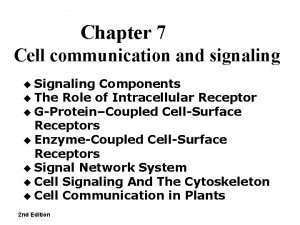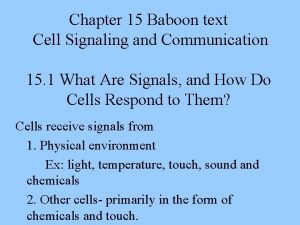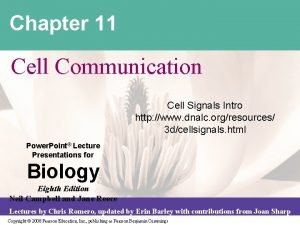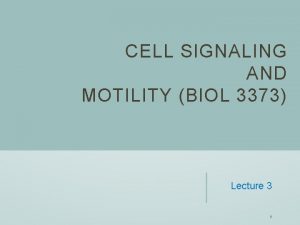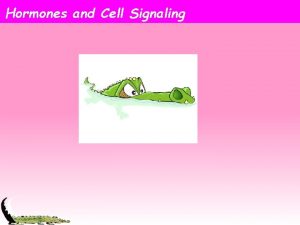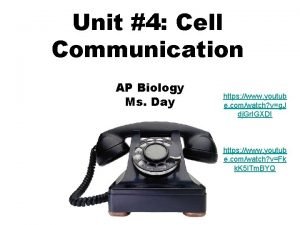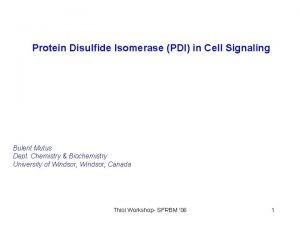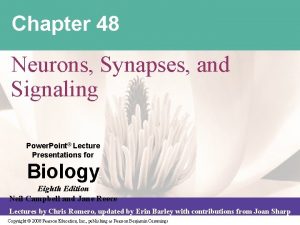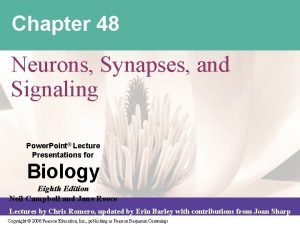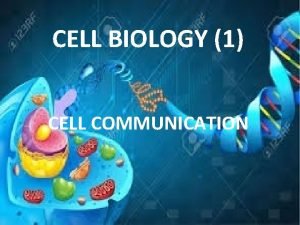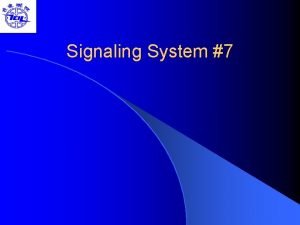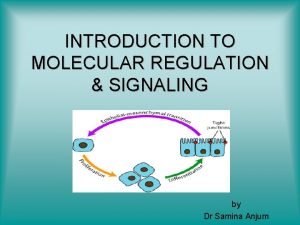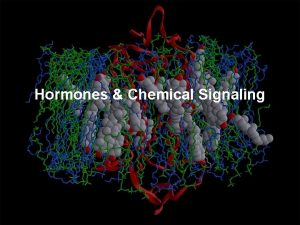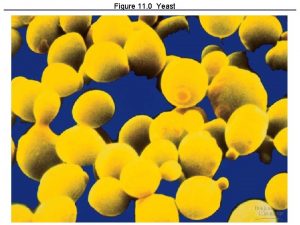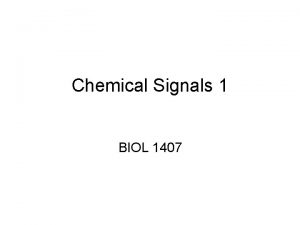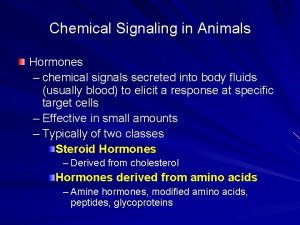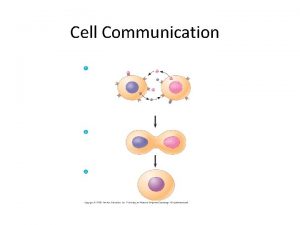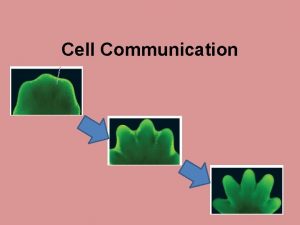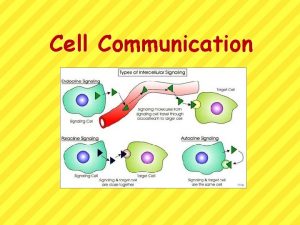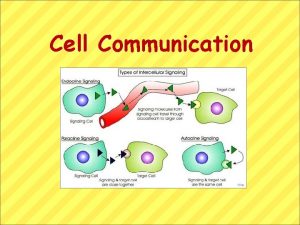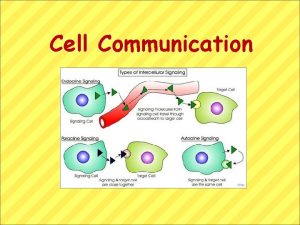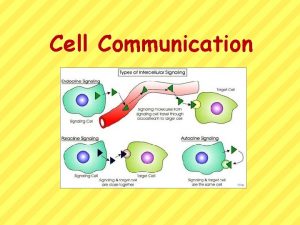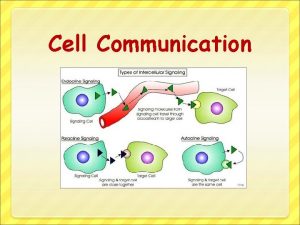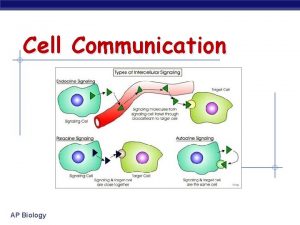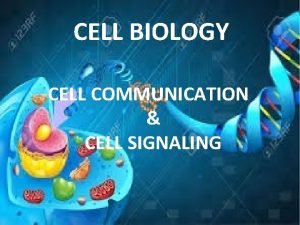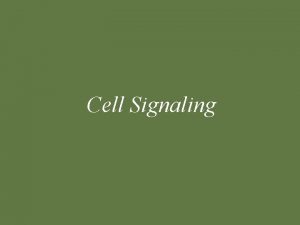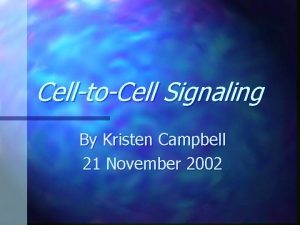Cell Communication Chapter 11 Importance Celltocell signaling is






















- Slides: 22

Cell Communication Chapter 11

Importance • Cell-to-cell signaling is important for multicellular organisms • Our trillions of cells must communicate with each other to coordinate their activities in a way that enables us to develop from a fertilized egg, grow and survive, and finally reproduce

Signal Transduction Pathway • The series of steps that occur when a signal on a cell’s surface is converted into a specific cellular response • For example) yeast cells recognize their mates by chemical signaling

Chemical Messengers • Cells in a multicellular organism communicate by chemical messengers • Animal and plant cells have cell junctions that directly connect the cytoplasm of adjacent cells • Animal cells may communicate by direct contact or cell-cell recognition

Local Signaling • In many other cases, animal cells communicate using local regulators • Local regulators are “chemical messengers” made and secreted by the signaling cell – Ex) Growth factors, which regulate target cells to grow and divide – Ex) Neurotransmitters released by nerve cells • Typically the local regulators travel short distances to the target cells, hence “local” signaling

Long-Distance Signaling • In long-distance signaling, plants and animals use chemicals called hormones • In animals, long-distance signaling = hormonal signaling = endocrine signaling • Specialized cells of the endocrine system release hormone molecules, which travel via the circulatory system to target cells in other parts of the body • In plants, hormones may travel in vessels but more often reach their targets by moving through cells (plasmodesmata) or by diffusing through the air as a gas

• Ex) the pancreas secretes insulin into the blood stream and it regulates sugar levels

3 Stages of Cell Signaling 1. Reception • • • The target cell’s detection of a signaling molecule (called a ligand) Occurs outside the cell on the cell membrane Signaling molecule binds to a receptor protein

2. Transduction • • The receptor protein is activated and changes shape This stage converts the signal to a form that can bring about a specific cellular response

3. Response • • The desired cellular response Can be a cellular activity such as activating an enzyme, rearranging the cytoskeleton, or activating specific genes in the nucleus

Reception • The binding between a signal molecule (ligand) and receptor is highly specific • A shape change in a receptor is often the initial transduction of the signal • Most signal receptors are plasma membrane proteins • There are three main types of membrane receptors: – G protein-coupled receptors – Receptor tyrosine kinases – Ion channel receptors

G Protein-Coupled Receptors Involved in vision, smell, embryonic development and more. Also, involved in many diseases such as cholera, pertussis, and botulism. The bacteria produce toxins that interfere with G-protein pathways

Receptor Tyrosine Kinases Involved in cell growth and cell division. One receptor can activate 10 or more different transduction pathways and cellular responses. Abnormal receptors may lead to cancer…

Ion Channel Receptors Important for the nervous system. Neurotransmitters sent from one neuron to the next bind to ion channels opening them initiating an electrical signal that travels down the neuron, “sending” the message

Reception • Not all receptor proteins are embedded in the cell membrane • Intracellular receptors are found in the cytoplasm of a cell or in the nucleus of target cells • Ligand must diffuse through the cell membrane to activate the receptor

Transduction: Protein Phosphorylation • In many pathways, the signal is transmitted by a cascade of protein phosphorylations • Protein kinases transfer phosphates from ATP to protein, a process called phosphorylation • Protein kinases are extremely important – about 2% of our genes code for them • Example) regulates cell reproduction

Transduction: Protein Dephosphorylation • Protein phosphatases remove the phosphates from proteins, a process called dephosphorylation • This phosphorylation and dephosphorylation system acts as a molecular switch, turning activities on and off

Transduction: Second Messengers • Second messengers are small, nonprotein, water -soluble molecules or ions • Second messengers can readily spread throughout cells by diffusion • Second messengers participate in pathways initiated by G-protein-linked receptors and receptor tyrosine kinases • 2 most common second messengers: – cyclic AMP – Calcium (Ca 2+)

cyclic AMP • cyclic AMP = c. AMP • Adenylyl cyclase, an enzyme in the plasma membrane, converts ATP to c. AMP in response to an extracellular signal • c. AMP usually activates protein kinase A, which phosphorylates various other proteins • Many signal molecules trigger formation of c. AMP

c. AMP Examples 1. Involved in the breakdown of glycogen caused by ephinepherine • Uses a G protein-coupled receptor 2. Cholera, a disease acquired by drinking water that is contaminated with human feces • • • The toxin produced by the cholera bacterium modifies the shape of a G protein so that it remains active causing the production of c. AMP Causes intestinal cells to secrete salt into the intestine and water follows Gives a person explosive diarrhea

Responses • Ultimately, a signal transduction pathway leads to regulation of one or more cellular activities • The response may occur in the cytoplasm or may involve action in the nucleus • Many pathways regulate the activity of enzymes • Many other signaling pathways regulate the synthesis of enzymes or other proteins, usually by turning genes on or off in the nucleus

Apoptosis • Programmed cell death • Signal often originates outside of the cell from a neighboring cell • Signals may also occur from inside the cell such as when the DNA has suffered irreparable damage or when numerous proteins are folded improperly • Necessary for development of fingers and toes
 3 types of cell signaling
3 types of cell signaling Respond to
Respond to 3 stages of cell communication
3 stages of cell communication 3 stages of cell communication
3 stages of cell communication Exocrine cell signaling
Exocrine cell signaling Cell signaling
Cell signaling Cell signaling overview
Cell signaling overview Pdi cell signaling
Pdi cell signaling Chapter 48 neurons synapses and signaling
Chapter 48 neurons synapses and signaling Chapter 48 neurons synapses and signaling
Chapter 48 neurons synapses and signaling Phrases signal example
Phrases signal example Register and signaling vocabulary
Register and signaling vocabulary Discourse organizers
Discourse organizers Vehicle ground guide hand signals
Vehicle ground guide hand signals Ligand signaling molecule
Ligand signaling molecule Signaling system 7
Signaling system 7 Autocrine and juxtacrine signaling
Autocrine and juxtacrine signaling Autocrine and juxtacrine signaling
Autocrine and juxtacrine signaling Chemical signaling
Chemical signaling Paracrine signaling
Paracrine signaling Chemical signaling
Chemical signaling Chemical signaling
Chemical signaling Strategies in embryonic and growth industries
Strategies in embryonic and growth industries
